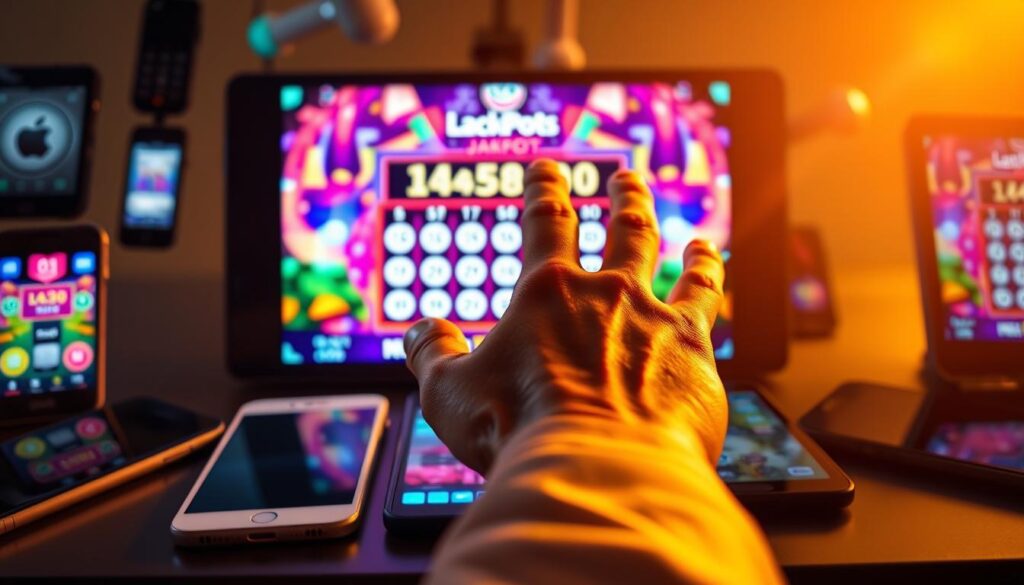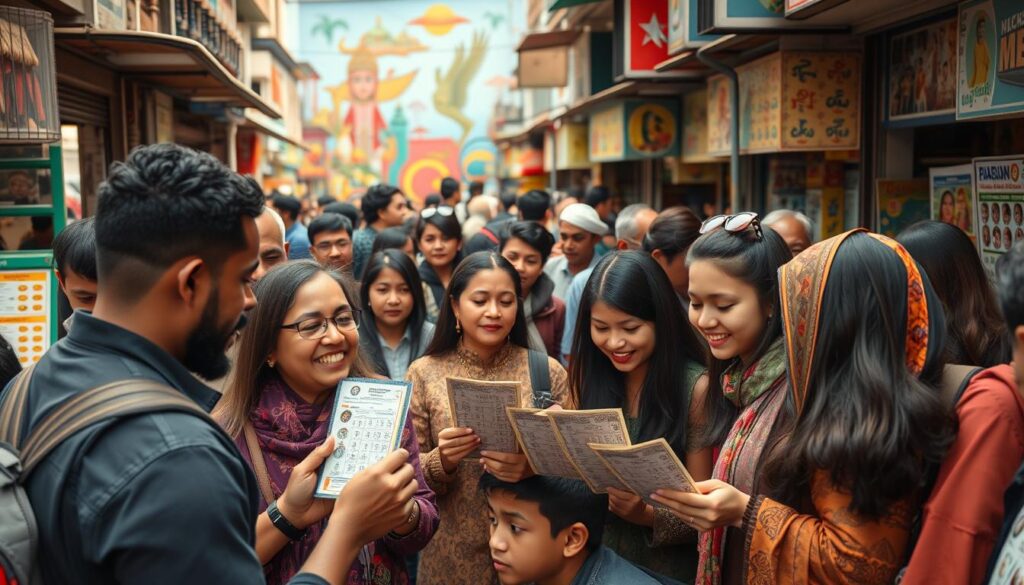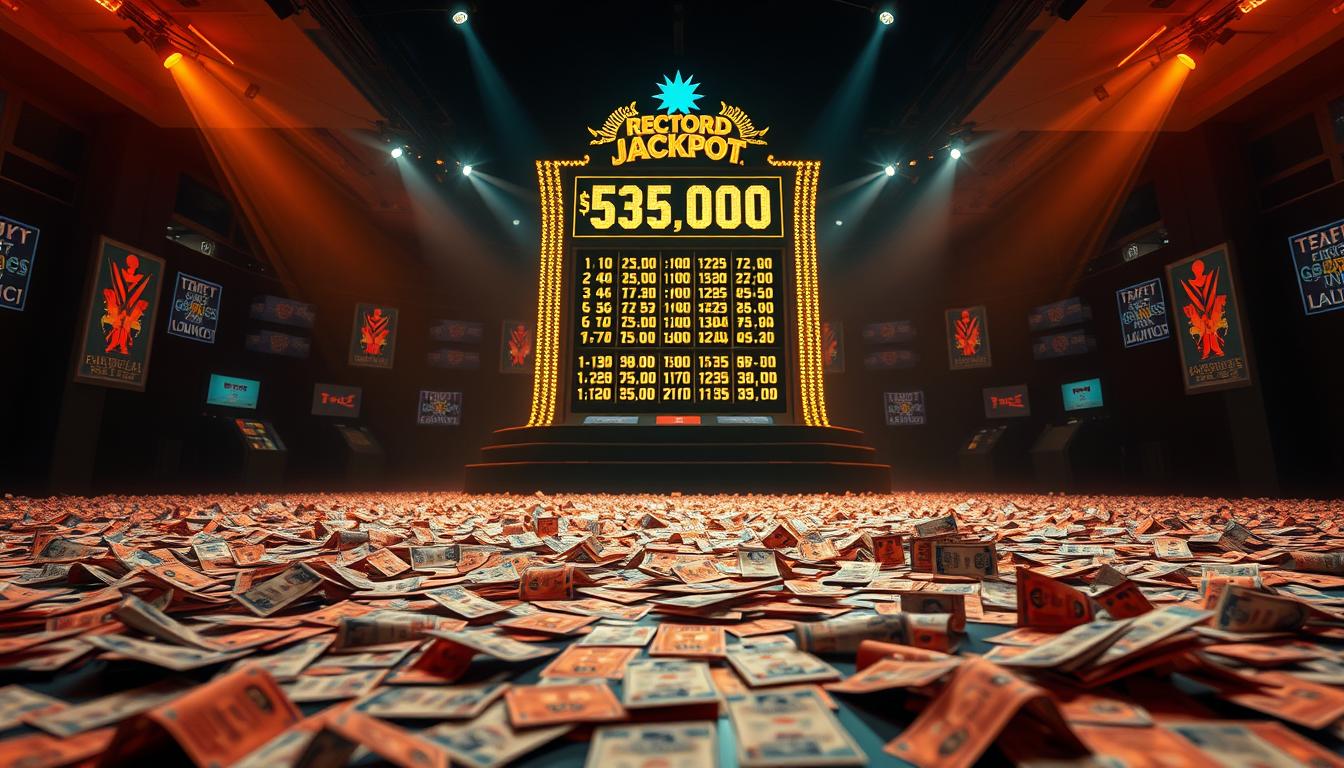We’re diving into the psychology of lottery playing and how jackpot sizes affect us. The lottery jackpot is a big part of our culture. In 2020, Americans spent $90 billion on lottery tickets, mostly for Powerball and Mega Millions. It’s important to understand why we play the lottery, including the thrill of winning and the influence of others.
Winning the jackpot in a Pick-6 lottery is rare, with odds of 1 in 593,775. Yet, about 80% of tickets will match at least one number. This mix of hope and chance leads to a surge in ticket sales when big jackpots are up for grabs. We’ll look at how jackpot sizes influence our desires and actions.
We aim to fully grasp the psychology of lottery playing. We’ll focus on its benefits and the chances it offers. By understanding what drives us to play, we can see how jackpot sizes affect our desires.
Key Takeaways
- The psychology of lottery playing is complex and involves factors such as risk vs. reward and jackpot sizes.
- Jackpot sizes significantly impact player behavior, with larger jackpots driving increased participation.
- The odds of winning the jackpot are low, but the potential rewards are high, making it an attractive option for many players.
- Understanding the psychology of lottery playing can help players make informed decisions and set realistic expectations.
- The lottery industry has experienced significant growth, with Americans spending billions on lottery tickets each year.
- The average ticket price for lottery tickets is around $2, making it an accessible form of entertainment for many people.
The Psychology Behind Lottery Jackpot Attraction
We are drawn to the lottery jackpot attraction for many reasons. The dream factor is a big one. It’s the hope of winning a life-changing prize. The risk vs. reward factor also matters, as we think about the good and bad sides of playing.
Cognitive biases also play a part. These include the availability heuristic and the gambler’s fallacy. They shape how we think and act.
Research shows that about 70% of lottery players think they can win. This is because of availability bias. They focus on the winners, not the losers. This cognitive bias makes us more likely to play.
The dream factor and risk vs. reward also matter. We think about the good and bad of playing. This helps us decide if we should play.
Knowing the psychology behind lottery jackpot attraction helps us make better choices. By understanding cognitive biases, the dream factor, and risk vs. reward, we can play with a clearer mind.
Why Bigger Jackpots Drive Increased Participation
Bigger jackpots attract more people to lottery games. The chance to win a large sum motivates players. They see it as a chance to change their lives for the better.
The biggest Powerball jackpot was $2.04 billion in November 2022. This huge prize caused a big jump in ticket sales. Daily sales went up by over 600% from the usual monthly average. This pattern is seen in other big jackpot lotteries too.
There are several reasons for this rise in participation. The excitement of winning a big prize is one. Playing with friends and family adds a social element. Many also play to help good causes, as lotteries often support public programs.
In conclusion, bigger jackpots lead to more people playing the lottery. The promise of a big win is too enticing to resist. We’ll look deeper into why people are drawn to lottery games in the next section.
The Social Impact of Large Lottery Prizes
We see that big lottery wins can really change things. They affect how people act in their communities and how the media reports on them. When big drawings happen, people often gather to share in the excitement. The media helps build up the anticipation.
Some important points about the social impact of big lottery wins are:
- More people get involved and talk to each other.
- There’s a lot of media coverage and public interest.
- Groups of people might join together to buy tickets.
Understanding the social impact of big lottery wins helps us see how lotteries shape our communities and media. As we dive deeper into the world of lotteries, it’s key to think about how these games affect our society.
How Jackpot Sizes Shape Our Lottery Playing Desires: A Scientific Perspective
Jackpot sizes greatly affect our desire to play the lottery. From a scientific perspective, research shows that bigger jackpots make us more excited. The chance of winning doesn’t change how excited we get.
Studies reveal that jackpot sizes boost our lottery playing desires. They make us feel hopeful and excited. The brain reacts the same way to dreaming about winning as it does to actually winning. This makes us want to play more.
Our lottery playing desires are also shaped by the game’s scientific perspective. Words and images can make us feel more excited. Plus, big jackpots bring people together, making them talk about their chances of winning.
The Economics of Escalating Jackpot Sizes
We know how key economics is when jackpot sizes go up. As jackpots grow, we must tweak revenue patterns and prize setups. This keeps the game profitable and fair for everyone.
Our aim is to give you a safe, fun, and rewarding online gaming time. We offer the newest and most thrilling slot games. This way, every player has a good shot at winning. The escalating jackpot sizes make the game exciting, while keeping it financially sound for the future.
Important things to think about in the economics of escalating jackpot sizes include:
- Revenue patterns and prize structures
- Economic impact on communities
- Player behavior and preferences
By grasping these points, we craft a game that’s both thrilling and sustainable. With escalating jackpot sizes, we aim for big wins. Yet, we also focus on a positive economic impact on our players and communities.
Digital Age Impact on Lottery Participation
We live in a digital age where technology changes everything. The lottery world is no different, with online games and social media changing how we play. Many now play lottery games from home, thanks to the digital age.
Online gaming has made playing lottery games easier. Many online sites offer lots of games and prizes. Social media also helps build excitement for big drawings, with players sharing their experiences and tips.
Here are some key statistics that highlight the impact of the digital age on lottery participation:
- In 2017, total U.S. lottery sales were $72.5 billion, with $22.6 billion going back to states.
- In 2018, gaming revenue hit $41.7 billion, the highest ever.
- By October 2019, 45 states had lotteries, 24 had commercial casinos, and 18 allowed sports betting.

Understanding Probability vs. Prize Size
The link between probability and prize size is key for those who play the lottery. At Dewakoin, we aim to give a safe, fun, and rewarding online gaming space. We offer the newest and most thrilling slot games, with big winning chances for all.
Players can use math to figure out the odds of winning and the possible prizes. For instance, winning the jackpot in a standard lottery game (6 from 49) has odds of 1 in 13,983,816. In Powerball (5 from 69 + 1 Powerball), the odds are 1 in 292,201,338.
Mathematical Odds Analysis
Mathematical odds analysis calculates the chance of winning based on possible outcomes. It helps players know their winning chances and plan their play. Important things to think about include:
- The number of possible outcomes
- The probability of winning
- The potential prize size
Risk Assessment Strategies
Risk assessment strategies look at the risks and benefits of playing. They help players understand the outcomes of their strategy and decide based on risk. Key points to consider are:
- The potential risks of playing
- The potential benefits of playing
- The player’s risk tolerance
Cultural Differences in Lottery Participation
Exploring lottery participation worldwide shows that cultural differences are key. Global perspectives on jackpot sizes and regional playing patterns shape how people play. In some places, playing the lottery is fun and social. In others, it’s seen as a serious investment.
Research shows that lottery participation rates differ by demographics. For example, in Maryland, 43% of whites played the lottery recently. But 68% of blacks did the same. In New Jersey, blacks and Hispanics play numbers games twice as much as others.
Here are some key statistics on regional playing patterns:
- 65% of Canadians buy lottery tickets weekly.
- Over 45% of gamblers buy lottery tickets monthly.
- In the fiscal year 2018-2019, the lottery made $3.7 billion in Ontario.

It’s important for lottery operators and marketers to understand these cultural differences and global perspectives. This helps them create strategies that meet the needs of different players.
The Role of Marketing in Jackpot Perception
Marketing has a big role in how people see jackpots and how they play. It creates excitement and gets more people to join in. In the U.S., lottery ads are among the top 50, spending over $300 million a year.
Marketing really changes how people decide to play lottery games. A study showed that for every $1 on ads, $2.11 comes back in revenue. This shows how good marketing can boost sales and earnings.
Some important facts about marketing’s effect on players include:
- About one-third of adults play the lottery each week. Over a year, it’s half or more of adults.
- The top 10% of players spend 50% of all money wagered. The top 20% spend about 65%.
Knowing how marketing affects jackpot perception and player behavior helps us create better strategies. These strategies can increase participation and revenue in the lottery world.
Responsible Gaming Considerations
We know how vital responsible gaming is for our players. At Dewakoin, we aim to offer a safe and fun online gaming space. We stress the importance of setting personal limits and spotting problem gambling signs.
Setting personal limits helps keep gaming healthy. This might mean playing for less time or spending less money. It’s also key to know the problem gambling signs. These include spending more than planned, ignoring important tasks, and feeling upset when you can’t play.
- Benefits of responsible gaming include a more enjoyable and secure gaming experience
- Consequences of problem gambling can include financial problems, relationship issues, and mental health concerns
By focusing on responsible gaming, we aim for a positive gaming experience for everyone. We urge all players to set personal limits and watch for problem gambling signs. If you or someone you know is struggling, please get help. We’re dedicated to a safe and responsible gaming space for all.
Conclusion – Finding Balance in Lottery Participation
The big draw of large lottery jackpots can really influence how much we play. But, it’s key to keep things in check to make sure playing is fun and safe. By understanding why we play, the risks, and the money side of things, we can play smarter.
Setting limits and knowing when to stop are important. The chance of winning big is very small. So, enjoying the game more than chasing big wins is a good way to play responsibly.
Seeing the lottery as a form of entertainment, not a way to get rich, is the best approach. This way, we can enjoy the thrill of playing without getting too caught up.
FAQ
What is the psychology behind lottery jackpot attraction?
The attraction to lottery jackpots is complex. It involves dreams, the balance between risk and reward, and biases like the availability heuristic and the gambler’s fallacy.
Why do bigger jackpots drive increased lottery participation?
Bigger jackpots attract more players because they offer higher rewards. This makes players more willing to take risks for a chance at a life-changing win.
How do large lottery prizes impact communities and media coverage?
Big lottery prizes can change how communities act and get media attention. During big draws, people come together to share in the excitement. Media coverage builds the anticipation and hype.
How can jackpot sizes shape our lottery playing desires from a scientific perspective?
Science shows jackpot sizes affect how we play the lottery. By studying the psychology and neuroscience, we learn how jackpot sizes influence our brains and actions.
What are the economic considerations of escalating jackpot sizes?
Escalating jackpot sizes have economic implications. They affect revenue, prize structures, and community impact. As jackpot sizes grow, the game’s profitability and sustainability must be ensured.
How has the digital age impacted lottery participation?
The digital age has changed lottery play. Online gaming and social media have made it easier to play from home. They also build excitement for big draws.
How can players understand the relationship between probability and prize size?
It’s important for players to understand probability and prize size. By analyzing odds and assessing risks, players can make better choices about their play.
How do cultural differences impact lottery participation?
Cultural differences affect lottery play. Global and regional patterns influence how people play. Different cultures view risk, reward, and luck differently, shaping their play.
What is the role of marketing in shaping jackpot perception?
Marketing shapes how we see jackpots and influences play. By creating excitement for big draws, marketers encourage more people to play.
What are the responsible gaming considerations for lottery players?
Responsible gaming is key to avoid problem gambling. Setting limits and recognizing signs of trouble help keep play fun and safe.
